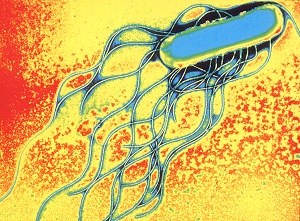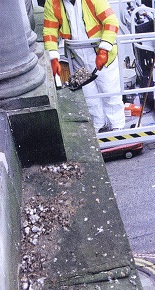ABC PEST CONTROL
CALL US NOW ON
0800 5118129 OR 07970 454573
Same Day Service
Free Quote and Survey
Unmarked Vehicles
Fatal Infections from Feral Birds

Anyone involved in clearing up after feral birds, droppings or their nesting materials in the course of their work, should be aware of the risks of Ornithosis.
Ornithosis is an acute, infectious disease caused by the bacterium Chlamydia psittaci. The bacteria live in the gut of infected birds and are passed out in the faeces and in eye and nasal secretions. The disease was first recognised in association with psittacine birds such as parrots and budgerigars at the turn of the century, when it was called psittacosis. Three decades later, an outbreak associated with other bird species occurred, and the term ornithosis was coined. It first appeared in pigeons in 1941, and whilst common in pigeons today, it is now accepted that most species of birds including gulls and poultry can excrete Chlamydia psittaci.
Chlamydia psittaci can be picked up by humans via the inhalation of faecal dust, or by contact with infected feathers, carcasses or birds' nests. The disease organism becomes less infectious with time, therefore active roosts will present the greatest risk to humans. In the early stages, ornithosis exhibits as an influenza-like illness causing fever and bad headaches. The development of a sore throat with a cough, muscle pain, lethargy and depression may follow. Symptoms may be mild and may well pass unnoticed and unreported, therefore the number of humans affected with ornithosis each year is difficult to establish. If diagnosed early enough, the disease can be successfully treated with antibiotics. However, if allowed to develop, it can become serious, leading to hospitalisation and even death in certain cases.
Due to the nature of the disease, PCOs may not always be aware that they are at risk. Although pest controllers may not have been specifically contracted to do bird clearance work, they may still be exposed to the bacteria causing ornithosis. This is particularly so in areas which are devoid of live birds, such as roof spaces or ducting systems. Here, the potential of contamination from old droppings or bird waste still exists and should be taken into account when carrying out a risk assessment.
Ornithosis is an acute, infectious disease caused by the bacterium Chlamydia psittaci. The bacteria live in the gut of infected birds and are passed out in the faeces and in eye and nasal secretions. The disease was first recognised in association with psittacine birds such as parrots and budgerigars at the turn of the century, when it was called psittacosis. Three decades later, an outbreak associated with other bird species occurred, and the term ornithosis was coined. It first appeared in pigeons in 1941, and whilst common in pigeons today, it is now accepted that most species of birds including gulls and poultry can excrete Chlamydia psittaci.
Chlamydia psittaci can be picked up by humans via the inhalation of faecal dust, or by contact with infected feathers, carcasses or birds' nests. The disease organism becomes less infectious with time, therefore active roosts will present the greatest risk to humans. In the early stages, ornithosis exhibits as an influenza-like illness causing fever and bad headaches. The development of a sore throat with a cough, muscle pain, lethargy and depression may follow. Symptoms may be mild and may well pass unnoticed and unreported, therefore the number of humans affected with ornithosis each year is difficult to establish. If diagnosed early enough, the disease can be successfully treated with antibiotics. However, if allowed to develop, it can become serious, leading to hospitalisation and even death in certain cases.
Due to the nature of the disease, PCOs may not always be aware that they are at risk. Although pest controllers may not have been specifically contracted to do bird clearance work, they may still be exposed to the bacteria causing ornithosis. This is particularly so in areas which are devoid of live birds, such as roof spaces or ducting systems. Here, the potential of contamination from old droppings or bird waste still exists and should be taken into account when carrying out a risk assessment.

Of course, ornithosis is just one example of the numerous diseases which can be transmitted to man by starlings, pigeons, gulls and other pest birds. Many more bacterial, viral, fungal, protozoan and rickettsial agents are responsible for causing allergic and infectious illnesses in humans. Studies have shown that certain bacterial species of Salmonella, Listeria and Escherichia found in bird droppings can cause acute gastro-intestinal infections. In particular, the relatively new pathogenic strain E. coli 0157 has received much media coverage in recent times and has led to a number of deaths in relation to outbreaks of food poisoning. Whilst these cases were not directly related to people coming into contact with bird faeces, the potential for infection should not be ignored.
In addition, the protozoan Toxoplasma, causing Toxoplasmosis, and the viruses Paramyxovirus and Arbovirus, causing Newcastle disease and encephalitis respectively, are all organisms frequently associated with bird droppings.
In addition, the protozoan Toxoplasma, causing Toxoplasmosis, and the viruses Paramyxovirus and Arbovirus, causing Newcastle disease and encephalitis respectively, are all organisms frequently associated with bird droppings.
Of the fungal diseases, cryptococcosis, caused by Cryptococcus neoformans and histoplasmosis, caused by Hystoplasmosis capsulatum, are commonly associated with guano, and therefore, pose a significant threat to human health. Both affect the lungs initially, but cryptococcosis can spread to the nervous system. Histoplasmosis, whilst usually mild, may produce a fatal TB-like illness in some people. Spores from C. neoformans are primarily found in pigeon droppings at elevated roost sites, although H. capsulatum is uncommon in pigeon droppings and occurs more frequently in droppings on soil underneath roosts.
The risks associated with bird droppings vary according to location, so risk assessment should consider the potential presence of all infectious agents. Whilst workers may normally be at most risk from ornithosis, in active roost sites, for example, there is more risk of acquiring histoplasmosis from roost sites older than three years or, when handling soil, the spores from H. capsulatum can remain there for many years.
It is always advisable for anyone entering potentially infected areas to wear appropriate personal protective equipment. It also pays to be extra vigilant and carry a card informing colleagues or physicians of the work in which they are involved - it could save their life.
The risks associated with bird droppings vary according to location, so risk assessment should consider the potential presence of all infectious agents. Whilst workers may normally be at most risk from ornithosis, in active roost sites, for example, there is more risk of acquiring histoplasmosis from roost sites older than three years or, when handling soil, the spores from H. capsulatum can remain there for many years.
It is always advisable for anyone entering potentially infected areas to wear appropriate personal protective equipment. It also pays to be extra vigilant and carry a card informing colleagues or physicians of the work in which they are involved - it could save their life.
